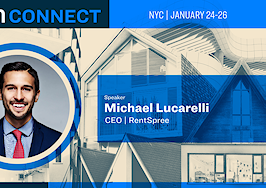New markets require new approaches and tactics. Experts and industry leaders take the stage at Inman Connect New York in January to help navigate the market shift — and prepare for the next one. Meet the moment and join us. Register here
A year that quickly soured for the people and professionals involved in buying and selling houses stayed pretty sweet in many ways for investors big and small who use real estate to generate income.
Inman reporter Jim Dalrymple II called 2022 the year that the #@!$ finally hit the fan. A spike in interest rates, paired with high home prices, caused a perfect storm that finally (and rapidly) chilled off the real estate market.
Yet much of 2022 was a banner year for the small and large investors who use real estate to generate income. In fact in some ways, the COVID housing market and eventual slowdown in buyer activity was good news for investors.
Rent continued to rise at unusually high rates. Those high rates attracted major players, including Wall Street investors who started buying houses by the thousands, sometimes partnering directly with builders to create entire single-family rental communities.
Short-term rental investors rushed to add supply to meet continuously rising demand from travelers who still looked to stay in unique places across the world, one night at a time, pushing nightly rates higher.
On the property portfolio beat at Inman, we focus on long-term rentals, short-term rentals, institutional investors, property management and the broader business of making money by using real estate as an investment.
With the rental market lagging behind for-sale real estate by as much as six months, here are the major trends that have shaped the last 12 months:
Rent approaches a precipice?
Fresh off a record-breaking year of rent growth in 2021, the rental market saw the unprecedented runup in prices continue to start the year.
Annual rent appreciation is typically around 2-4 percent, according to CoreLogic. It’s been rising as much as four times faster than that, reaching record highs before recently dipping month over month.
The pace of year-over-year rent growth appears to have peaked in February, when rent was 17.1 percent higher than a year before. It has continued to soften throughout the year.
“It’s like that roller coaster where it’s going up and up and up and up,” said Molly Boesel, an economist at the real estate data provider CoreLogic. “You don’t know what’s going to happen when you get to the top.”
For most of the country and most of the year, the storyline was the slowdown in rent growth, not a year-over-year decline. We’re now in a landscape where the cost of rent is much higher than what it was before the pandemic started.
“Since February 2020, single-family rents have grown 26 percent,” Boesel said. “Even with the slowdown in growth, and even should we hit some low growth numbers, I believe that 26 percent increase is here to stay.”
That doesn’t mean things will remain peaches in either the single-family or multi-family sectors.
“Rent growth is going to slow,” said Rob Dietz, chief economist for the National Association of Home Builders. “That will take some momentum away from the multi-family market.”
Certain markets are already showing signs of vulnerability. Whereas rent was up 22 percent at the end of 2021 in Las Vegas, it was up just 0.4 percent year over year in 2022. A similar slowdown was seen in Phoenix.
Rental data powerhouse RealPage reported demand for new leases in U.S. apartments was the weakest it had been in three decades in the third quarter, as people delayed forming new households until seeing what would happen with the economy.
Dietz, along with apartment powerhouse CoStar, both expect that slowdown to continue into the new year before rebounding.
“In 2023, both single-family and multi-family are likely to contract,” Dietz added. “What that sets us up for is that by the end of ‘23, the Federal Reserve is likely going to be in a place where it has to begin to ease some of the tightened monetary policy.”
Key stories:
Q2: Multifamily rent slows in latest sign of rental market cooldown
Single-family rental prices tripled their rate of growth in 2021
Slowdown in apartment rent expected to continue, CoStar says
Rent keeps falling. Here are the cities where it’s falling fastest
Weakest Q3 for US apartment leasing in 3 decades
Fractional ownership has its day
The idea of owning a portion of a home had been gathering steam among industry insiders for a few years, but largely in concept.
But 2022 may have been the year that the concept became reality.
Fresh off funding rounds from major players like Amazon founder Jeff Bezos, Arrived went on a buying spree, scooping up single-family homes in supply-constrained markets across the country.
Investors got in on it, too, rapidly scooping up entire houses in a matter of minutes. The demand was so intense that it crashed the Arrived Homes site in May. The investors still bought more than a dozen homes worth more than $3 million within hours.
It happened again in the same month, when investors bought six houses in eight minutes and caused disruptions on the site.
The flurry of activity, along with expansions by competitors like Mynd, which began buying homes in the Midwest in May, gave credence to the idea of fractional ownership.
“Think about what they’re doing: You can get on Arrived, you push a button and you own a real estate asset,” said Ross Hair, a broker at Mille Real Estate in Boulder, Colorado.
Arrived eventually capitalized on another trend of the year: In September it started offering homes to investors that would be used not as long-term rentals. They’d be rented out on short-term rental platforms like Airbnb.
Ember, another fractional ownership company that typically caters to people looking to buy shares in second homes, also got in on the short-term rental action. It announced in August it would allow owners to generate extra income by renting out portions of their six weeks.
Key stories:
Rush to invest in latest rentals crashes Bezos-backed Arrived Homes
Jeff Bezos-backed Arrived dives into short-term rental market
Ember moves to allow owners to use shares as short-term rentals
Rental investing platform Mynd sees opportunity outside Sun Belt
Everything you need to know about fractional real estate investing
Airbnb didn’t go bust. (Not by a long shot.)
Social media lit up in October because of one Tweet with five simple words: “The Airbnbust is upon us.”
The Tweet, from an analyst in Texas, was shared widely, with some people suggesting high fees and lengthy checkout requirements were causing people to stop booking on the biggest short-term rental platform by far.
But the prophecy was greatly exaggerated.
The Airbnbust is upon us#Airbnb pic.twitter.com/2BMTjGhiox
— Texas Runner DFW (@texasrunnerDFW) October 16, 2022
The two big players in short-term rentals are actually doing quite well, as are the investors and independent homeowners who use the platforms to make money from short-term stays.
That doesn’t mean it’s all smooth sailing.
AirDNA, a leading provider of short-term rental analytics, said in its 2023 forecast that occupancy rates are expected to begin falling next year. That’s due in large part to a rapid increase in supply, rather than changes in demand.
With all eyes on national economic performance in the new year, things could continue to change for investors if a recession starts eating into travel demand.
Investors who are heavily leveraged on short-term rental properties they bought when prices and interest rates were high would be most at risk of even a slight downturn.
AirDNA expects the elevated monthly payments on investment properties that aren’t owned outright will make it tougher for investors to turn a profit.
Some of the pressure might actually come from Airbnb itself, which has recently begun making moves to increase the supply of units on its platform.
Airbnb recently partnered with some of the biggest property owners in the nation to allow long-term rentals to rent out their apartments on a short-term basis. It has also remained focused on making it easier for people to become Hosts.
Meanwhile, the company recently switched on a feature that allows travelers to see the full price of an Airbnb when searching. It says its algorithm will soon prioritize rentals that guests have said provide great value for the price.
Airbnb bust? Not hardly. But it looks like things will get more competitive in the near future for short-term rental investors.
Key stories:
‘The Airbnbust is upon us’: A tweet hints at Airbnb’s fall. But is it right?
How Airbnb investors can minimize risks when buying properties
Airbnb pledges to make prices more transparent following strong Q3
Vrbo bookings grew in Q3 amid surge in short-term rental demand
Airbnb partners with building owners to let renters act as hosts
New York City seeks to tighten control over Airbnbs
The pandemic party for short-term rental investors is ending
Flippers activity booms, then hits a brick wall
This was among the first segments of the real estate investment market to see activity plunge with the broader slowdown.
Near the peak of the for-sale market, buyers of all kinds were making offers in hyper-competitive markets. And it wasn’t just traditional buyers. Investors of all sizes were competing for scant inventory.
Activity by investors soared to a record high in the first quarter, when one out of every five homes sold went to a limited liability company, a trust or corporation, according to Redfin.
But if all good things are to come to an end, flippers found out before many other investors. Those subject to the impact of interest rates saw risk skyrocket, as buyers held out for prices to come down.
Some independent fix and flip investors say they’re not even looking for traditional deals anymore.
Investor activity fell by 30.2 percent in the third quarter compared to a year ago. That slowdown outpaced the 27.4 percent drop in overall home purchases nationwide, according to Redfin.
The share of investor purchases fell to 17.5 percent by the end of September. That remains nearly three times higher than what it was two decades ago.
Key stories:
Share of investor sales activity rose to record high in Q1: Study
Home flipper activity jumps, while profitability plummets
Families aren’t only buyers feeling heat from Wall Street investors
Don’t blame investors for run-up in home prices, Freddie Mac says
Investor activity plunged at rates similar to the Great Recession in Q3
Home flippers search for ‘creative deals’ as high rates cool the market
Institutional investors and built-for-rent housing
The year saw a growing interest from major Wall Street players who are getting more involved in the rental housing industry.
And investors are hitting the gas pedal.
Dietz said the share of single-family homes that are being built with the intention of remaining rentals has quadrupled when looking at sales to investors and real estate investment trusts who manage rentals.
“Historically, it’s been about 3 percent of starts,” Dietz said. “It represents 11-12 percent of single-family housing starts right now.”
“Going from 3 percent to about 12 percent is a pretty big gain,” he added. “That’s a reflection of the fact that housing conditions on the for-sale side of the market have declined so much.”
While they still account for the smallest share of all investors (mom and pop landlords account for about half of all investor purchases) the growth of private equity players in the single-family rental market was noteworthy.
Investors who bought upwards of 1,000 properties — CoreLogic calls them “mega investors” — slowed down their purchases of single-family homes toward the end of the year. But their activity remains above historical levels.
JPMorgan Chase recently announced that it was taking two steps into the rental space. First, it rolled out a new property management platform for landlords, investors and tenants. Shortly after, it said it was injecting $4 billion into the purchase of rental properties.
Earlier this month, Lennar — the second biggest homebuilder in the nation — announced it was offering 5,000 single-family homes to investors.
And the trend is expected to continue moving forward.
The slight dip in activity by major investors is likely a sign that they’re waiting for prices to fall so they can source more deals.
“Homebuilders nationwide found themselves with a sudden surge of unsold inventory when mortgage rates rose suddenly, triggering cancellations as buyers could no longer afford the monthly payment,” said Brad Hunter, head of Hunter Housing Economics. “Although the investor-operators see this opportunity, they are also looking to buy at a discount.”
In 2021, there were just under 95,000 single-family homes started with the intention of being rented rather than sold. Hunter expects that number to grow to 150,000 by 2025.
Key stories:
Welcome to the new neighborhood. These homes aren’t for sale
Congress targets investors and asks: ‘Where have all the houses gone?’
Cincinnati scores big win against institutional real estate investors
Blackstone makes major expansion of rental housing portfolio
Families aren’t only buyers feeling heat from Wall Street investors
Get Inman’s Property Portfolio Newsletter delivered right to your inbox. A weekly roundup of news that real estate investors need to stay on top, delivered every Tuesday. Click here to subscribe.


















